Search the Special Collections and Archives Portal
Search Results
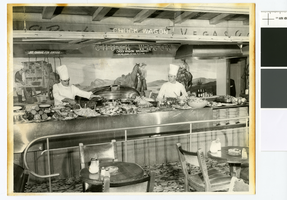
Photograph of the Chuck Wagon Buffet at the El Rancho Vegas (Las Vegas), late 1940s
Date
Archival Collection
Description
Two cooks standing ready for diners at the Chuck Wagon Buffet at the El Rancho Vegas. Stamp on back of photo: "Las Vegas News Bureau, Las Vegas-Nevada, Photographers Don English, Joe Buck, Jerry Abbott, 0791."
Site Name: El Rancho Vegas
Address: 2500 Las Vegas Boulevard South
Image
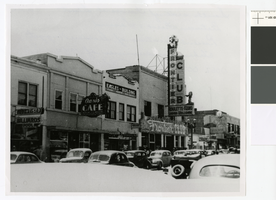
Photograph of the south side of Fremont Street (Las Vegas), summer of 1942
Date
Archival Collection
Description
A view of the south side of Fremont Street showing the Oasis Cafe, Fraternal Order of the Eagles (F.O.E.) building, and the Frontier Club. This is the present location of the Golden Nugget. Handwritten text on original: "South side of Fremont Street between First & Second. Present location of Golden Nugget. Taken in summer of 1942. Howard J Werner"'
Site Name: Fremont Street
Address: Fremont street, Las Vegas, NV
Image
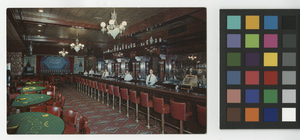
Postcard showing the Golden Nugget Gambling Hall interior (Las Vegas), after 1946
Date
Archival Collection
Description
Photographic postcard featuring table games and the bar area of the Golden Nugget Gambling Hall. Transcribed from original: "The Million Dollar Golden Nugget Gambling Hall, Saloon and Restaurant, Las Vegas. Thousands of visitors are attracted annually by the lavishly decorated Casino with its Crystal Chandeliers, Famous Paintings and Mahogany Beams, reminiscent of the Barbary Coast days." Publishing info from original: "Plastichrome' by Colourpicture, Boston 15, Mass -- 6270 Mosley Ave., L.A."
Site Name: Golden Nugget Las Vegas
Address: 129 East Fremont Street
Image
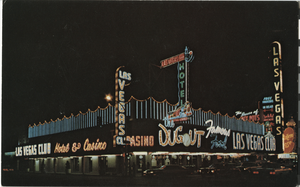
Postcard showing the Las Vegas Club at night (Las Vegas), 1975
Date
Archival Collection
Description
Photographic postcard showing the Las Vegas Club, Main and Fremont at night. Printed text on back of postcard: "Located in the very heart of downtown Las Vegas, the LAS VEGAS CLUB combines traditional friendliness with superbly comfortable accommodations. Your stay in Las Vegas will be more memorable when you make the LAS VEGAS CLUB your headquarters for fun and relaxation. Main & Fremont, Downtown Casino Center, Las Vegas, Nevada. Kolor View Press, Los Angeles, Ca., 90064, 213-272-8615."
Site Name: Las Vegas Club
Address: 18 East Fremont Street
Image
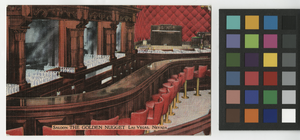
Postcard showing the saloon in the Golden Nugget, (Las Vegas), after 1946
Date
Archival Collection
Description
Photographic postcard showing the curved bar at the saloon area of the Golden Nugget. Transcribed from original: "Golden Nugget Gambling Hall, Saloon and Restaurant. 'Where Fortune Smiles.' See the old-style west in our modern world. A place of mahogany bars, crystal chandeliers, with the genuine hospitality and old-time gaiety of the Barbary Coast and the Virginia City of fifty years ago." Publishing info from original: "Art Tone 'Glo-Var' Finish - Associated Litho. Des Moines 9, Iowa."
Site Name: Golden Nugget Las Vegas
Address: 129 East Fremont Street
Image
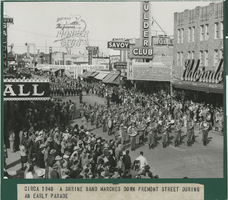
Photograph of a parade on Fremont Street (Las Vegas), 1948
Date
Archival Collection
Description
Transcribed from original: "Circa 1948. A Shrine band marches down Fremont Street during an early parade." This parade was in support of the 1948 elections, as indicated by the banner in the photo, urging citizens to vote Democratic: Harry S. Truman for President, Alben W. Barkley for Vice-President, and Walter S. Baring, Jr. for Congress. The following buildings and signs can be seen in the photograph: Overland Hotel; Pioneer Club; Club Savoy; Boulder Club; Eldorado; Golden Nugget Saloon.
Site Name: Fremont Street
Address: Fremont street, Las Vegas, NV
Image
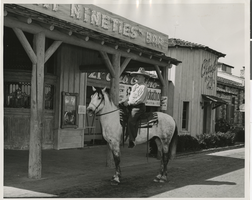
Photograph of Francis X. Brownhofer in front of the Gay Nineties Bar at the Last Frontier Village, 1944
Date
Archival Collection
Description
Francis X. Brownhofer on a horse in front of the Gay Nineties Bar in the Las Frontier Village at the Last Frontier Hotel. Transcribed from original: "Francis X. Brownhofer, purchasing agent and catering manager of Brown Derby, Hollywood. Set up food operations for Last Frontier." Next door is the 21 Club.
Site Name: Frontier
Address: 3120 Las Vegas Boulevard South
Image

Postcard showing Binion's Horseshoe (Las Vegas), 1980s
Date
Archival Collection
Description
Color view of the facade of Binion's Horseshoe. Transcribed from original: "Binion's Horseshoe Club. Downtown Las Vegas. The 'Bright Spot,' on the world's brightest 2 blocks, featuring the largest electric sign in the world. Long famed for 'Fast Action' the HORSESHOE HOTEL & CASINO has 100 guest rooms, 24-hour restaurant, 3 cocktail bars, 'round-the-clock' casino, air curtain and FREE inside parking." Publishing info from original: "'Mirro-Krome' by H. S. Crocker Co., Inc., Los Angeles, Calif. Dist by. Douglas Venable. 920 E. Bonanza Rd., Las Vegas, Nev."
Site Name: Horseshoe Club
Address: 128 East Fremont Street
Image
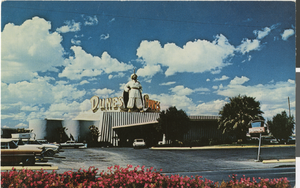
Postcard showing the entrance of the Dunes Hotel (Las Vegas), mid 1960s
Date
Archival Collection
Description
Dunes Hotel front entrance and porte-cochère. Transcribed from original: "The Dunes Hotel, Las Vegas, Nevada. This beautiful hotel on the Las Vegas Strip has been referred to as the 'Miracle of the Desert,' 'a thousand and one delights.' The hotel's impressive entrance, beautiful gardens and casino are all unsurpassed and the Arabian Room nightly presents the nation's finest floor shows." Publishing info from original: "Western Resort Publications, 1320 N. Broadway, Santa Ana, Calif. Copyright Ferris H. Scott, Santa Ana, Calif."
Site Name: Dunes Hotel
Address: 3650 Las Vegas Boulevard South, Las Vegas, NV
Image
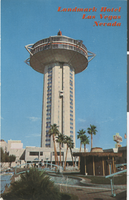
Postcard showing the Landmark Hotel (Las Vegas), 1970s
Date
Archival Collection
Description
View of the Landmark Tower; Transcribed from back of postcard: "Landmark. A Hughes Resort Hotel. Las Vegas, Nev. 89109. Above all in Las Vegas, the Landmark Hotel, 31 stories above the Las Vegas 'Strip.' Great entertainment in 2 exciting showrooms - dining in 4 lavish restaurants - dancing in the fabulous skybar - Nevada's longest swimming pool, complete with waterfalls, bridges and an island bar... no wonder the Landmark is called the most unique resort hotel in the world." Publishing info from original: "Ektachrome by Chet Kranz, Las Vegas, Nevada."
Site Name: Landmark Hotel and Casino
Address: 364 Convention Center Drive, Las Vegas, NV
Image
